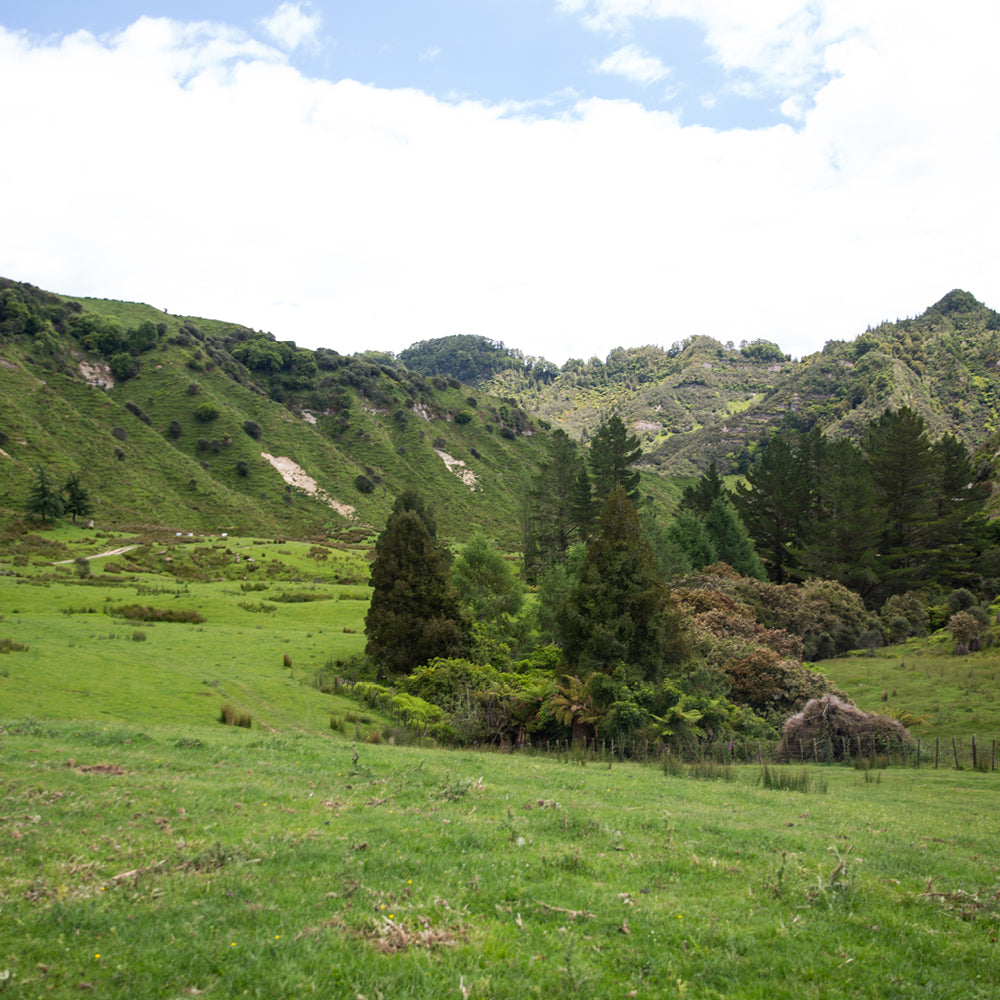Read Time: 3 minutes
Summary:
High in the hills of New Zealand, Manuka Doctor is helping restore native bushland by replanting thousands of Manuka trees on former farmland. Once seen as a weed, Manuka is now key to sustainable honey production—and ecological renewal. The planting programme not only supports bee populations with extended nectar sources but also revives native ecosystems. It’s a powerful reminder that the rising demand for Manuka honey is fueling more than wellness trends—it’s helping nature heal.

It’s early spring and I’m on a remote mountainside with the Manuka Doctor team, visiting one of their new planting sites for Manuka bushes. This wild countryside, deep in the green heart of New Zealand’s North Island, can only be accessed by helicopter or a bumpy hour-long ride over gravel and dirt tracks from the nearest main road.
Going back 180 years, the vast mountainous land here would have been almost completely covered in Manuka and other native plants, a dense mix of rainforest-like vegetation known as the “New Zealand bush”. But European settlers who set up home in the country from the mid-1800s onwards saw Manuka as a weed and cleared millions of acres of native bush to create grazing pastures for sheep and cattle.
Now, thanks to the burgeoning popularity of Manuka Honey, the native habitat is slowly being regenerated.
Try a new Manuka recipe today!

The planting team I’m following today is working hard to repopulate the Manuka bush over one of their properties, a 5,800-acre area of former farmland. They’re aiming to plant 1,100 stems per hectare at a spacing of 3m by 2m, so one every 9 square metres.
It’s not easy work in the heat: it’s only 10am and I’m already having to slather myself in suncream to protect my pasty Celtic skin from the force of the New Zealand sun. The crew are digging holes in the rich soil by hand to create enough space to house Manuka’s root system, before carefully placing every stem in the ground and packing soil back around its base to keep it secure.
Not every stem planted will survive but up to seven or eight in every ten will grow from a seedling into an adult bush around five metres tall. It means that within the next five or so years, this mountainside - currently bare of anything except grass and the odd foxglove - will become covered once again by the carpet of native Manuka trees which historically made their home here. Every year, these Manuka bushes will bloom for six to 12 weeks, providing nectar for the thousands of bees living in hives on this land, who use it to make Manuka Honey.
It is thanks to the increasing recognition of the wellbeing benefits of Manuka Honey, and the consequent growth in demand for the product, that companies like Manuka Doctor are now able to invest in creating a sustainable future for the native bush environment.

Nicola Macfarlane, who is organising the company’s planting project, explains: “Manuka naturally grows here but it’s important for us to sustain that with a carefully managed programme of planting. “The flowering life of a Manuka bush is around 20 years, so we need to ensure we are replacing bushes which have reached the end of their flowering life to guarantee a long-term supply. “It’s not just Manuka we’re planting – we’re bringing in a number of other native pollen sources which flower at different times of the year, including New Zealand flax.
“For us, the planting programme is about ensuring the sustainability of Manuka and promoting the natural, native New Zealand environment, as well as guaranteeing a supply of nectar for our bees.”
The planting team are also helping widen understanding of the Manuka bush’s characteristics by studying which varietals perform best in different habitats. Here on the mountainside it is warm in direct sunshine on a clear day but the relatively high altitude and changeable New Zealand weather means the average temperature is too cold for some varietals of Manuka. Test planting projects in this area have helped the crew identify four native types which thrive in the mountain environment – and it is a mix of these which will take root over this land over the next few years.
Each varietal has a slightly different flowering period and can bloom one after another. When different types are planted together, it means bees not only benefit from the varied diet, but can collect more Manuka nectar over a longer period every summer.

I can’t help but feel inspired by the sight of hundreds of fledgling Manuka saplings reaching up from the mountainside towards the blue sky. Not only does their growth guarantee a future food source for honey bees, but it is a symbol of how this ancient land is being returned back to its natural, native wilderness.
Read more: Is prevention better than cure: Manuka Honey, immune system and more





